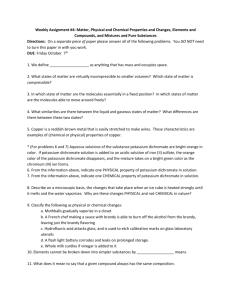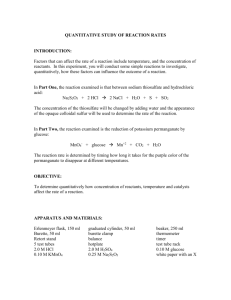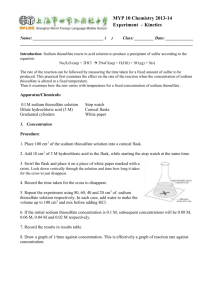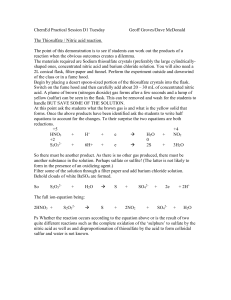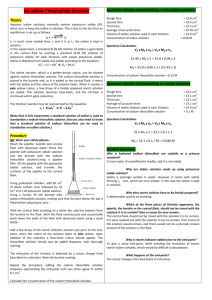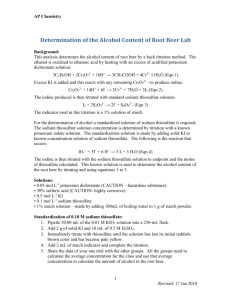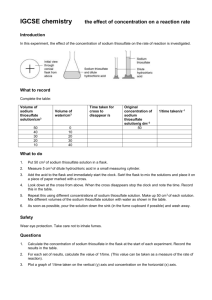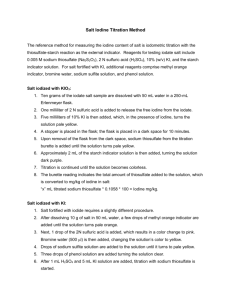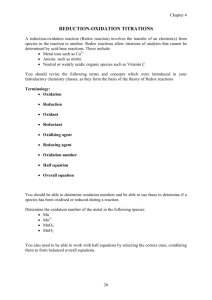Iodometry Titration: Sodium Thiosulfate Lab Protocol
advertisement
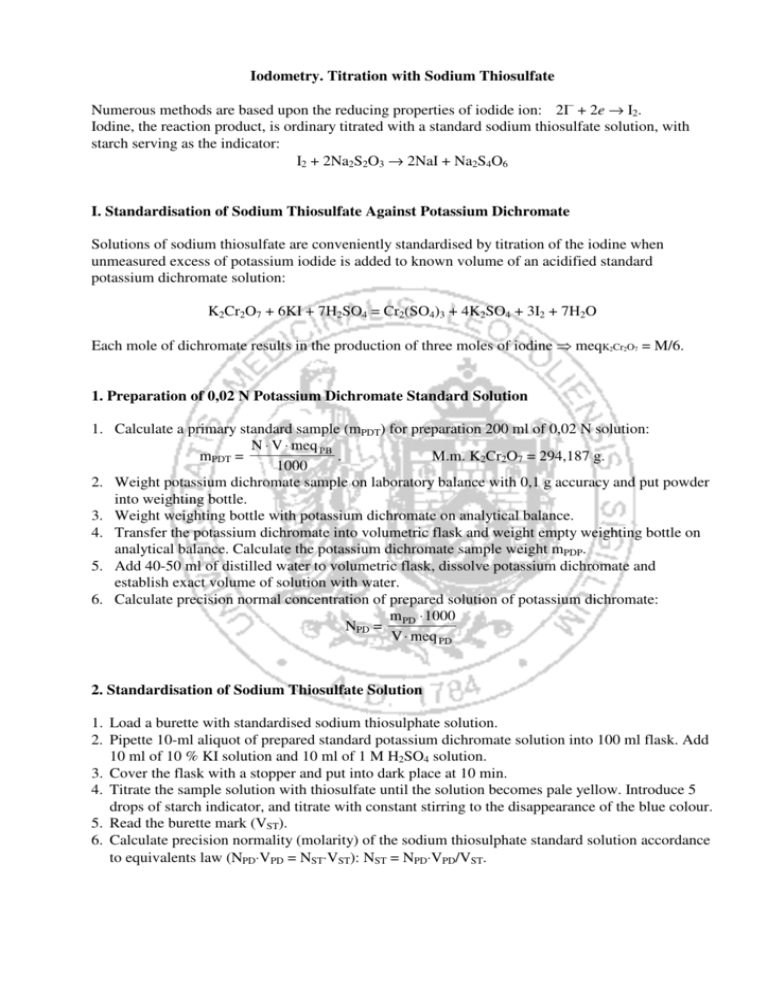
Iodometry. Titration with Sodium Thiosulfate Numerous methods are based upon the reducing properties of iodide ion: 2I– + 2e → I2. Iodine, the reaction product, is ordinary titrated with a standard sodium thiosulfate solution, with starch serving as the indicator: I2 + 2Na2S2O3 → 2NaI + Na2S4O6 I. Standardisation of Sodium Thiosulfate Against Potassium Dichromate Solutions of sodium thiosulfate are conveniently standardised by titration of the iodine when unmeasured excess of potassium iodide is added to known volume of an acidified standard potassium dichromate solution: K2Cr2O7 + 6KI + 7H2SO4 = Cr2(SO4)3 + 4K2SO4 + 3I2 + 7H2O Each mole of dichromate results in the production of three moles of iodine ⇒ meqK2Cr2O7 = M/6. 1. Preparation of 0,02 N Potassium Dichromate Standard Solution 1. Calculate a primary standard sample (mPDT) for preparation 200 ml of 0,02 N solution: N ⋅ V ⋅ meq РВ . M.m. K2Cr2O7 = 294,187 g. mPDT = 1000 2. Weight potassium dichromate sample on laboratory balance with 0,1 g accuracy and put powder into weighting bottle. 3. Weight weighting bottle with potassium dichromate on analytical balance. 4. Transfer the potassium dichromate into volumetric flask and weight empty weighting bottle on analytical balance. Calculate the potassium dichromate sample weight mPDP. 5. Add 40-50 ml of distilled water to volumetric flask, dissolve potassium dichromate and establish exact volume of solution with water. 6. Calculate precision normal concentration of prepared solution of potassium dichromate: m ⋅ 1000 NPD = PD V ⋅ meq PD 2. Standardisation of Sodium Thiosulfate Solution 1. Load a burette with standardised sodium thiosulphate solution. 2. Pipette 10-ml aliquot of prepared standard potassium dichromate solution into 100 ml flask. Add 10 ml of 10 % KI solution and 10 ml of 1 M H2SO4 solution. 3. Cover the flask with a stopper and put into dark place at 10 min. 4. Titrate the sample solution with thiosulfate until the solution becomes pale yellow. Introduce 5 drops of starch indicator, and titrate with constant stirring to the disappearance of the blue colour. 5. Read the burette mark (VST). 6. Calculate precision normality (molarity) of the sodium thiosulphate standard solution accordance to equivalents law (NPD⋅VPD = NST⋅VST): NST = NPD⋅VPD/VST. II. Iodine Determination 1. Add to conic flask 10 ml aliquot of problem solution (VI2). 2. Introduce 5 drops of starch indicator, and titrate with constant stirring to the disappearance of the blue colour. 3. Repeat titration also two times. Calculate the approximate value of used sodium thiosulphate standard solution (VST). N ST ⋅ VST ⋅ meq I2 ⋅ W 4. Calculate the iodine percentage in sample: x% = ⋅100% . VI2 ⋅ p Iod M.m. I2 = 254; meqI2 = M/2; pIod = 5,00; W = 1000. III. Back-titration of Formaldehyde with Iodine In alkali solution iodine is disproportioned accordance to equation: I2 + 2NaOH = NaOI + NaI + H2O Formaldehyde is oxidised with formed hypoiodite ion: HCHO + NaOI = HCOOH + NaI Surplus of hypoiodite in alkali solution is disproportioned to periodate: 3NaOI = NaIO3 + 2NaI In acidified solution periodate surplus removes to iodine: NaIO3 + 5NaI + 3H2SO4 = I2 + Na2SO4 + 3H2O, which are titrated with standard sodium thiosulfate solution. 1. Load a burette with 0,02 N standard sodium thiosulfate solution. 2. To conical flask pour in 10 ml aliquot of sample (VS), add 10 ml of 0,05 N iodine standard solution (VI2), and 10 ml of 1 M NaOH solution. 3. Cover the flask with a stopper and put into dark place at 10 min. 4. Add 10 ml of 1 M H2SO4 solution and titrate the sample with thiosulfate until the solution becomes pale yellow. Introduce 5 drops of starch indicator, and titrate with constant stirring to the disappearance of the blue colour. 5. Read the burette mark (VST). 6. Repeat titration also two times. Calculate the median volumes of used sodium thiosulfate standard solution. 7. Calculate formaldehyde percentage in sample: xHCHO = M.m. HCHO = 30,02; (VI 2 ⋅ N I 2 − VST ⋅ N ST ) ⋅ meq HCHO meqHCHO = M/2. VS ⋅ 100%

